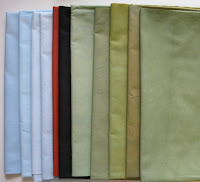 I'm back home from a couple of days of mixed media workshops in Chicago. I did two workshops; the first was on Thermofax screen printing taught by Pokey Bolton, and the second was on soy wax batik with Melanie Testa. For the screen printing workshop, we were able to send an image in advance, so at the workshop we each had a personal screen to work with, as well as other screens that Pokey brought with her. I sent in an ink drawing:
I'm back home from a couple of days of mixed media workshops in Chicago. I did two workshops; the first was on Thermofax screen printing taught by Pokey Bolton, and the second was on soy wax batik with Melanie Testa. For the screen printing workshop, we were able to send an image in advance, so at the workshop we each had a personal screen to work with, as well as other screens that Pokey brought with her. I sent in an ink drawing:
In my favorite piece, I printed it in two different directions, overlapping.
 Do double-click on these images for a much better view. The photo at the top of the entry is a detail of this wider piece. I like it. I may just mount it as is and put it on the wall. I like the process of printing quite a bit. One quilt I have in mind includes some repeated words/phrases. Printing might be a good way to get them onto fabric.
Do double-click on these images for a much better view. The photo at the top of the entry is a detail of this wider piece. I like it. I may just mount it as is and put it on the wall. I like the process of printing quite a bit. One quilt I have in mind includes some repeated words/phrases. Printing might be a good way to get them onto fabric.And here are a few of the many small pieces I did in the batik workshop. The first was one of several I did to see if I could get fabric usable for my quilts dealing with stones; the wax was applied with a paint brush. Yes, the resulting fabric works, though straightforward painting might do just as well, with less trouble.

The next one was done by first using paint to stamp black triangles onto the white fabric. Then I put wax down in larger triangles and painted all with black. (Thanks to Melanie, who gave me a mini-lesson on varying scale in pattern design as I was trying to figure out what to do after the small stamped triangles.)
 This next one was an experiment to see what I could do with a pattern like the one I used in the screen-printed piece, created here with a tjanting tool that allows one to "draw" in wax. The blobby squiggle came from turning the tool upside down by mistake.
This next one was an experiment to see what I could do with a pattern like the one I used in the screen-printed piece, created here with a tjanting tool that allows one to "draw" in wax. The blobby squiggle came from turning the tool upside down by mistake. And a last one--this one was to try out red and black together, playing around with a potato masher (the parallel lines) and a ravioli cutter (the squares). Another quilt I have in mind involves red and black, and it could be that batik (or printing) would be one way to get to the image I want.
And a last one--this one was to try out red and black together, playing around with a potato masher (the parallel lines) and a ravioli cutter (the squares). Another quilt I have in mind involves red and black, and it could be that batik (or printing) would be one way to get to the image I want. So, I had fun learning a couple of new techniques, with the guidance of two excellent teachers, and there's a chance one or both of these will be of use in future quilts. Before the summer comes to an official end, there's one more technique I want to try out--painting with thickened dyes (rather than the acrylic paint I've used before). More complicated, but different results.
So, I had fun learning a couple of new techniques, with the guidance of two excellent teachers, and there's a chance one or both of these will be of use in future quilts. Before the summer comes to an official end, there's one more technique I want to try out--painting with thickened dyes (rather than the acrylic paint I've used before). More complicated, but different results. 









